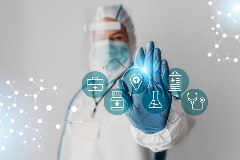Imagine a housing estate transformed into an urban experiment for innovative solutions or smart headphones that serve as sight for the visually impaired. These cutting-edge advancements in digital healthcare and smart technology, very much a part of our reality today, were highlighted at the “Harnessing Technology For A Better Tomorrow” session. This is one of the events under the Smart Technology and Connectivity pillar of the “See The Possibility” campaign series, organised by the NUS Development Office.
The development and adoption of technology have helped societies raise productivity and inclusivity of services and improve overall wellbeing. But on the flip side of the coin, this progress has also brought forth a new set of challenges that the world will need to grapple with.
In this event, the speakers will touch on the various aspects of the impact of technology and how we can better harness technology for social good while mitigating risks.
.jpg?sfvrsn=d3ec23b3_1)
Guests enjoyed the event at the Innovation 4.0 building.
bf506ba4-1bd6-470e-ac35-fff113b56a4d.jpg?sfvrsn=f26391d9_1)
NUS President Professor Tan Eng Chye welcomes guests to the event and shares his vision for the University.
Behind every big scientific breakthrough lies an essential element — visionary benefactors. These individuals and organisations provide the fuel propelling groundbreaking discoveries that benefit our health, security and quality of life. As NUS researchers and scientists are raring to change the world with their technological innovations, donors to NUS can be patrons of social progress by championing and funding their research.
In his opening speech, NUS President Professor Tan Eng Chye (Science ’85) said, “The impact of philanthropy cannot be understated. When donors like you support research and development, and the University, you give our research, researchers, and scientists a light to explore uncharted territories and to carry out explorations that may not be possible under more conventional funding.”
Some of these revolutionary developments are unfolding before our eyes and making a significant impact on our lives. At the event, NUS researchers passionately showed how their inventions go beyond the lab to solve real-world problems of real people. The brilliant minds behind these promising projects are seeking funding to make their vision a reality.
Uncovering Solutions to Ageing and Living Well
CURATE.AI is just one example of the University’s savvy strategy for interdisciplinary research. Solving the complex problems we face in today’s world calls for diverse teams, where specialists tap into their expertise to formulate holistic solutions. Professor Aaron Thean, NUS Deputy President (Academic Affairs) and Provost, shared the examples of two cross-disciplinary initiatives, Health District @ Queenstown and NUS Cities.
The secret to solving one of the world’s most pressing issues can be found in one of Singapore’s oldest housing estates. Through an initiative co-led by NUS, the Queenstown neighbourhood is now a living lab where researchers explore innovative solutions, including smart technology, to tackle the challenges of an ageing population.
.jpg?sfvrsn=2c3835ef_1)
Provost Prof Thean shared how the University leverages its diversity for interdisciplinary research to address diverse problems of modern society.
“Singapore is one of the fastest ageing nations in Asia, so we have the perfect testbed to understand this problem and find the solution. One of the ways to do that is to convert the entire town into an actual experiment… You can test technological, policy, and medical solutions in a living, breathing lab. This is not only reshaping the way we do healthcare in Singapore, but also actually establishing thought leadership worldwide,” said Prof Thean.
Other than uncovering solutions for Singapore’s increasingly ageing population, NUS is also breaking new ground in research on urban sustainability through NUS Cities.
The NUS Cities programme brings together communities of engineers, designers, and scientists who are exploring the challenges of urban cities and conceptualising ideas to make them more liveable, sustainable, and resilient. Such research is pertinent as over 70% of the world’s population will live in cities by 2050.
Prof Thean said, “We are solving problems related to sustainability and climate change, building resilient and liveable cities, data information, and digital health materials. All these issues actually cross-fertilise to create new opportunities… There are lots of problems, lots of solutions to be found, and lots of opportunities to explore the connections.”
Stopping Tech from Going Rogue
As others sing praises about the advantages of harnessing smart technology, NUS Professor Mohan Kankanhalli sings a different tune — and for good reason.
Remember the viral image of Pope Francis wearing a white puffer coat? Scores of people did a double-take at the shockingly realistic photo that was, in fact, a creation of AI. Generative AI has been heralded as the earth-shattering technology of our time. These intuitive AI tools are akin to having a personal assistant at work and at home. Developers tap on it to fix bugs in codes, office executives use it to refine their emails, stay-home mums task it to plan meals and boyfriends generate love poems to up their romance game.
4227d584-b84d-4be5-9607-460759260581.jpg?sfvrsn=ff474082_1)
Prof Kankanhalli warns against misusing technology.
Tackling the trending subject at the event, Prof Kankanhalli cautioned about the negative impact of technology, from creating fake news to breaching data privacy. As such, he is championing research to make the internet a safe space and prevent these tools designed for good from being exploited.
“Anybody on the street can create fake news… You can create images of a tsunami in Clementi or in the NUS campus. It’s not just images, you can create videos and texts. We at NUS are taking this very seriously. We are tackling misinformation and disinformation. We are looking into how to mitigate the problem in this new era of generative AI when fake news of high quality can be created very easily,” said Prof Kankanhalli, Provost’s Chair Professor of Computer Science at NUS. He is also the Director of NUS Centre for Research in Privacy Technologies, and the Deputy Executive Chairman of AI Singapore.
As our physical lives are becoming more interwoven with technology, it is increasingly important to safeguard our digital lives. Data privacy is a cause of concern everywhere as people stay connected via social media, and organisations conduct their businesses virtually.
Prof Kankanhalli believes that an important tool for protecting personal and sensitive data is machine unlearning, a new area of computer science teaching AI to delete all traces of a person or data.
He explained, “Suppose you have signed up for an account in a social media company, where you have posted your photos. The company has trained its machines for friend recommendations based on your data. But let’s say you want to unsubscribe from there and delete your account. You want your account not only to be deleted, but you also want your data to be removed from any kind of machine learning algorithms. There are privacy laws that state that you as a consumer have a right to be forgotten. If you tell an organisation to remove you, it's not just deleting you from the database, but also removing you from the machine learning model”.
Digital Therapy in a Digital Era
A patient with stage four prostate cancer was running out of time and options — enter an AI tool that offered a glimmer of hope. Called CURATE.AI, the AI-powered platform prescribes an optimal drug dosage based on the individual’s data. In this miraculous case, the patient took CURATE.AI’s recommendation, lowered the dosage and achieved the lowest cancer marker during the course of treatment.
This AI medical marvel has been a decade in the making, and today, it promises patients personalised care with maximum effectiveness. The team’s ultimate goal is to make individualised healthcare affordable and accessible to all. But their remarkable results or future endeavours would not have been possible without the generosity of donors.
“Donor support accelerates our innovations to patients and enables us to help as many patients as possible. As our studies have shown, we can truly optimise patient treatment in the clinic, which has been foundational to how we demonstrate real-world impact,” said Professor Dean Ho, Director of the Institute for Digital Medicine (WisDM) and the N.1 Institute for Health. He is also the Provost’s Chair Professor and Head of the NUS Department of Biomedical Engineering.
As personalised healthcare and technology converge, there are endless possibilities on the horizon. Children with ADHD (Attention Deficit Hyperactivity Disorder) are prescribed video games to improve their attention span, chronic insomniacs turn to apps to train themselves to sleep better and longer. Diabetic patients can rely on a digital health buddy to stay motivated and keep their blood sugar levels in check.
This new class of medicine, digital therapeutics, is the subject of Prof Ho’s new book, “Medicine without Meds: Transforming Patient Care with Digital Therapies”, which he co‐authored with his teammates Mr Yoann Sapanel and Ms Agata Blasiak. Digital therapeutics treat, manage or prevent a medical condition using software programmes via mobile apps or web-based platforms. Backed by clinical evidence, these digital interventions are designed to provide therapeutic benefits and often complement traditional healthcare.
With the team’s groundbreaking work gaining international recognition, even the United States Food and Drug Administration (FDA) is knocking on their doors for advice.97b235cd-48d2-406e-ad8b-7346a52a210b.jpg?sfvrsn=1e7e5410_1)
Prof Ho speaking with guests after his talk on using AI to enhance healthcare.
Prof Ho said, “The FDA is the global beacon for regulating new drugs, new devices and beyond. The world looks to the FDA for the future of healthcare regulations. The FDA is watching us in Singapore, how we are truly dynamic in individualising patient care, and how we have completely rethought how to design clinical trials... This is truly a shining moment for us at NUS and for Singapore when the global beacon for the regulation of healthcare comes in and asks us how we do what we do.”
Visionary Innovations for Healthcare and Beyond

Exhibitors showcase the latest innovations.

Guest trying out the HOPES device.
While some scientists answer the call to address global challenges, others draw inspiration from their personal experiences. For instance, NUS PhD candidate Miss Yu Kelu’s drive to innovate was influenced by her father’s glaucoma diagnosis in 2019. Watching her father suffer from the eye disease, she co-created HOPES (Home Eye Pressure E-skin Sensor), a low-cost device to measure eye pressure at home. The biomedical device designed for glaucoma patients won the coveted international award from the iconic inventor Sir James Dyson’s foundation in 2021.
Miss Yu said, “My father’s uncomfortable treatment and frequent hospital visits left a deep impression on me and my family. This motivated me to delve deeper into the disease and its treatments. I later found out that accurate eye pressure measurement is crucial for glaucoma management.”
From gloves to headphones, seemingly ordinary everyday devices showcased at the event possessed extraordinary functions, with potential applications for digital healthcare. For instance, a pair of smart gloves is revolutionising the way doctors train to become skilled surgeons. HaptGlove allows users to experience virtual reality with unprecedented realism, a game-changing technology for healthcare and beyond.
.jpg?sfvrsn=b27c2054_1)
NUS President experiencing the HaptGlove’s haptic gloves.
“It is very difficult to find patients with specific diseases and let every medical student touch and feel palpable science, but in virtual reality with our haptic gloves, we were able to recreate those scenarios realistically and let medical students experience them and get better trained, so that they will be more confident when they see the real patients,” said Professor Lim Chwee Teck, who leads the research team and is the Director for the Institute for Health Innovation and Technology (iHealthtech).
Prof Lim added that HaptGlove’s ability to simulate reality could extend beyond simulating surgeries, such as entertainment and industrial training.
Meanwhile, the Project AiSee’s headphones hope to be eyes for the visually impaired community, empowering them with independence by accessing information on the go. The bone-conduction headphones are fitted with an AI-powered camera that identifies and describes the words or objects to the user. For instance, the user could find out the daily special on a restaurant menu by asking the assistive device.
.jpg?sfvrsn=36ab22c7_1)
Assoc Prof Nanayakkara showcasing AiSee.
Associate Professor Suranga Nanayakkara, NUS Department of Information Systems and Analytics, said, “At the Augmented Human Lab, we design technologies to empower people and allow them to do things beyond what they currently do. For example, AiSee allows blind people to point at things and get information… One day we can really make a product out of it and make a difference in the blind community.”
Philanthropy: Catalyst for Innovation
The cures we have for once-fatal illnesses, the conveniences we experience in everyday life — are made possible today because of research in the past. In order to solve present-day challenges, it is important to support researchers to uncover solutions in future.
A single act of giving can set in motion a chain reaction that inspires others to come forward to contribute, too. By investing in the future, the cycle of innovation does not stop.
Ms Winnie Thia, a guest at the event expressed, “It was inspiring to see how philanthropic gifts can support cutting-edge research to help make lives better through innovative smart technologies and capabilities. I was touched by Prof Dean Ho’s topic on AI for Better Healthcare where treatment can be personalised with NUS AI platform CURATE.AI.”
“The Stanford Doerr School of Sustainability was built with a generous gift of S$1.1 billion from John Doer and his wife Ann, the largest gift in Stanford’s history. The couple believes that Stanford is perfectly positioned to make a measurable difference in climate and sustainability challenges. Similarly, the building that houses MIT.nano will soon be named in honour of MIT alumna Lisa T. Su with a transformative gift. Such landmark gifts are crucial for universities such as NUS, to compete in the global arena. We need bold, world-class interdisciplinary research infrastructures that define thought leadership and support our researchers, especially seed funding for new talents looking into new disruptive research. A community of partners can solve the world’s biggest problems,” shared Prof Thean.
Addressing donors and guests, NUS President Prof Tan Eng Chye concluded, “In paying it forward, you inspire others to get involved. This motivates the next generation of researchers to evolve and be innovative. You have this cycle of generosity and innovation, and that leads to continued progress. With your strong support, NUS researchers and scientists can uncover insights, develop technologies, and make other breakthroughs in basic science and translational research to shape future solutions.”






